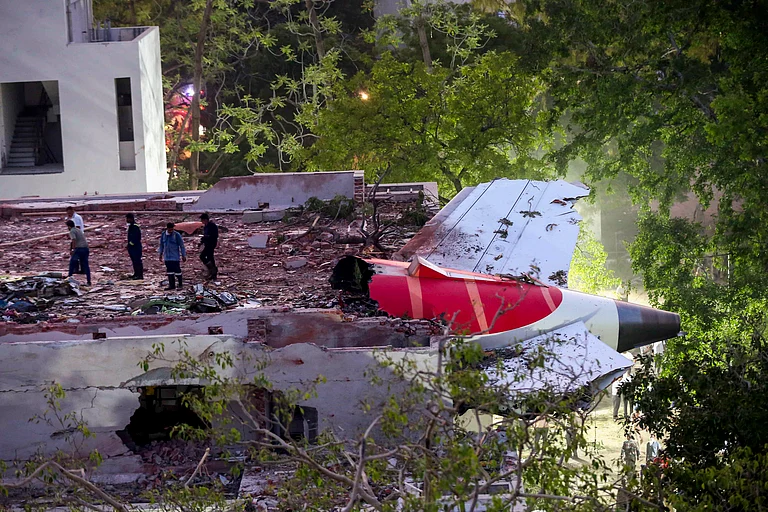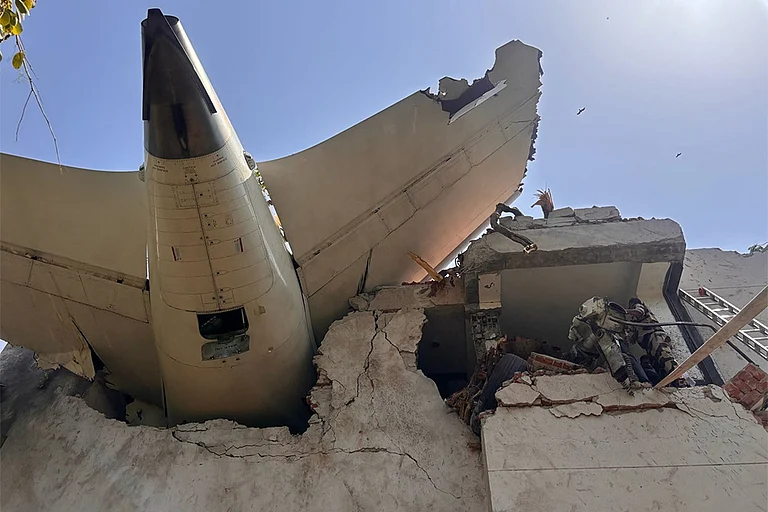Shortly after taking off from Sardar Vallabhbhai Patel International Airport in Ahmedabad on June 12, Air India Flight 171 crashed in the neighbouring area, killing more than 240 passengers in possibly the most tragic and shocking air disaster in 40 years. There’s a very good reason why the investigation into the cause of this crash is now a multinational global enquiry—with active oversight from the United Kingdom Civil Aviation Authority (UKCAA), the Federal Aviation Administration (FAA), the National Transportation Safety Board (NTSB), the European Union Aviation Safety Agency (EASA), Transport Canada, in addition to Boeing, the Directorate General of Civil Aviation (DGCA) and the Aircraft Accident Investigation Bureau (AAIB).
Ahmedabad Plane Crash: Now, Post-Mortem The Accident
The crash of Air India Flight 171 underlines the importance of investigation, implementing its recommendations and holding the Air India management responsible
The Minister of Civil Aviation has said that the investigation into the crash should be closed in three months or 90 days, which is an extremely naïve and premature statement to make. In truth, it must be the multinational team of investigators who should set the deadline since this crash will be a complex exercise. Every element of the technical systems must be reviewed and the investigation must establish what led both the engines to fail. Investigating the cause of the crash isn’t about being an endurance test or about setting any world record, it is about getting to know why the crash happened. The recommendations of the probe must put in place immediate procedures or systems, and if required, change or replace the entire aircraft components so that such a catastrophic crash never happens again.
This is the first-ever controlled flight air disaster involving the Boeing 787-8 Dreamliner aircraft—now operated by Air India, owned by the Tatas, with Singapore Airlines having a 25.1 per cent stake in the airline.
Over the past 20 years, passengers have raised concerns over the Government of India running a shoddy, loss-making Air India and its unions with an indifferent and arrogant attitude as far as service, quality and standards are concerned.
If It Ain’t Broke, Don’t Fix It
The problem with Air India is a systemic and malignant archaic structure along with an aging fleet, breaking aircraft and a maintenance backbone that can’t keep up with industry standards, reliability and product freshness. In 2022, the Indian Government handed over a ‘net-of-loss’ Air India to Tata and Singapore Airlines (SIA), and it was expected that an Air India under private management and ownership will begin addressing some of the glaring problems the airline faced.
And the Tatas are an expert with this—in the way they transformed Tata Motors and Tata Steel. This needed effort and supervision from Air India’s new management—to roll up its sleeves to fix the real problem on the ground. Instead, the management chose to ‘modernise’ the airline with an inane branding exercise and took the ‘jugaad’ path to solve the dilapidated product image with a painstakingly slow fleet induction process that will span five years of aircraft deliveries from Airbus and Boeing.
Air India is the only airline, since it became privately owned, with the highest amount of recorded safety violations linked to financial penalties and fines by the DGCA. This was with training lapses, crew proficiency, maintenance reliability shortfalls and quality control. With 95 per cent of Air India’s fleet being, on an average, between 15 and 20 years old, sooner or later there were bound to be signs of a possible breakdown with reliability and quality assurance.
Could The Crash Have Been Prevented?
What appears to have gone wrong with Air India Flight 171 is a complete loss of engine power that prevented the aircraft from climbing and/or continuing its flight, leading to the aircraft dropping like a rock. Eyewitness videos and data from Automatic Dependent Surveillance-Broadcast (ADS-B) suggest that Air India Flight 171 had enough thrust available to get off the ground to about 600 ft with an airspeed of 170 knots—close to the climb speed needed by the aircraft. But it now looks like that the aircraft, at 600 ft, suffered multiple failures—collapse of the total system as well as engine power and digital engine power management—presenting the aircraft with no option to climb and attempt to escape to safety.
From my assessment, the pilot’s aggressive attempt to pitch the nose up made it worse as it led to losing the most valuable element you need for aerodynamic flight—speed—leading the aircraft to stall, sink and drop like a rock. Why the complete loss of engine thrust and power happened should form the core element of the investigation for the multinational investigator delegation as everything—from engine maintenance, Full Authority Digital Engine Control (FADEC) to the sudden loss of power at 600 ft—must be scrutinised.
What appears to have gone wrong with Air India Flight 171 is a complete loss of engine power that prevented the aircraft from climbing and/or continuing its flight, leading to the aircraft dropping like a rock.
The very location of India’s airports is a matter of concern and a safety hazard during an emergency. Every Indian airport today is surrounded by extreme urbanisation with residential apartments, office blocks, colleges, hospitals and malls. And during a sudden event of loss of power with any aircraft, there’s no way any aircraft can be put down safely. There’s a very good reason why most airports in Europe and Asia ban urbanisation near and around airports to allow for better and safer controlled forced landings. And we know this when we take off from or land in an airport in Europe and Asia—all that one sees is agricultural fields that act as conducive options allowing for a safer and better controlled emergency landing.
Crack The Whip
The Air India conundrum is that the government does not own the airline. The Tatas and Singapore Airlines do. So it is time that those responsible in the management are held accountable. Fixing Air India needs to be a bottom-up approach, not top down ‘jugaad’. The findings from the investigation need to be put into immediate action—be it maintenance practices, phasing out an entire fleet or fixing the broken maintenance system that plagues Air India. Before Tata-SIA inducts more aircraft, it is imperative that they establish a robust airline maintenance structure and a system to support both existing aircraft and the new fleet.
Hold the Executives Accountable
Today, the worldwide benchmark to hold airline executives accountable for an air crash is the incident involving Luxair Flight 9642. On November 6, 2002, the aircraft lost control and crashed onto a field in Luxembourg during an attempted landing at the airport. Of the 22 passengers and crew members, only two people survived.
A criminal prosecution was launched, but was delayed until October 10, 2011. The captain of the flight, three former Luxair executives and three mechanics were charged with involuntary manslaughter and negligence. They were finally acquitted in 2012. While several gaps exist today with management control of Air India, will India’s civil aviation regulation and laws—now closely being modelled on the European Union Aviation Safety Agency (EASA)—implicate and indict Air India executives in the same manner as the Luxembourg courts did? Under the English Common Law, prevalent in India, you are innocent until proven guilty in a court of law. It is time the industry, the press and the public cease to place airline CEOs on a pedestal. It is time we held them accountable for their actions, if proven guilty.
Fix The House
With Delhi, Mumbai, Bengaluru, Hyderabad and Kolkata nestled in the midst of dense urbanisation, there’s now a zero chance of crash survivability when the chips are down and a pilot is unable to bring back the aircraft to the airport. India needs to relook all its airports and start making plans to relocate every airport as far away from dense urban catchments. This will be a long, slow and painful process, but it needs to be done.
With over 10 regulators, Boeing and nearly five foreign governments keenly monitoring the accident enquiry, I reckon this time, we should see the most unbiased, neutral and fiercely independent investigation and court of inquiry. With the world wanting to know what went wrong with the 787-8, factuality and prime facia evidence will be the lynchpin of the cause with what went wrong. The findings, such as they may be, have to be enforced, embedded and integrated into operations worldwide. And those responsible must be held accountable and should be indicted to the fullest extent of the law so that we never see such a crash ever.
India, the world, Air India, airports and safety regulators have a lot of work to do. I hope the Government of India and Prime Minister Narendra Modi crack the whip on this one and set the standards for the world to follow.
(Views expressed are personal)
Mark D. Martin is founder & CEO of Martin Consulting, an aviation safety and consulting firm based in Asia

